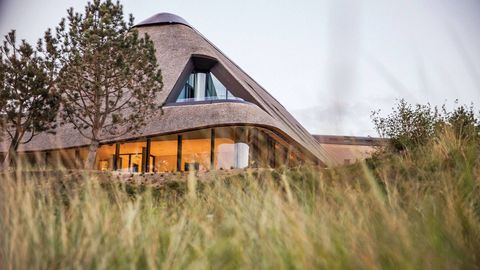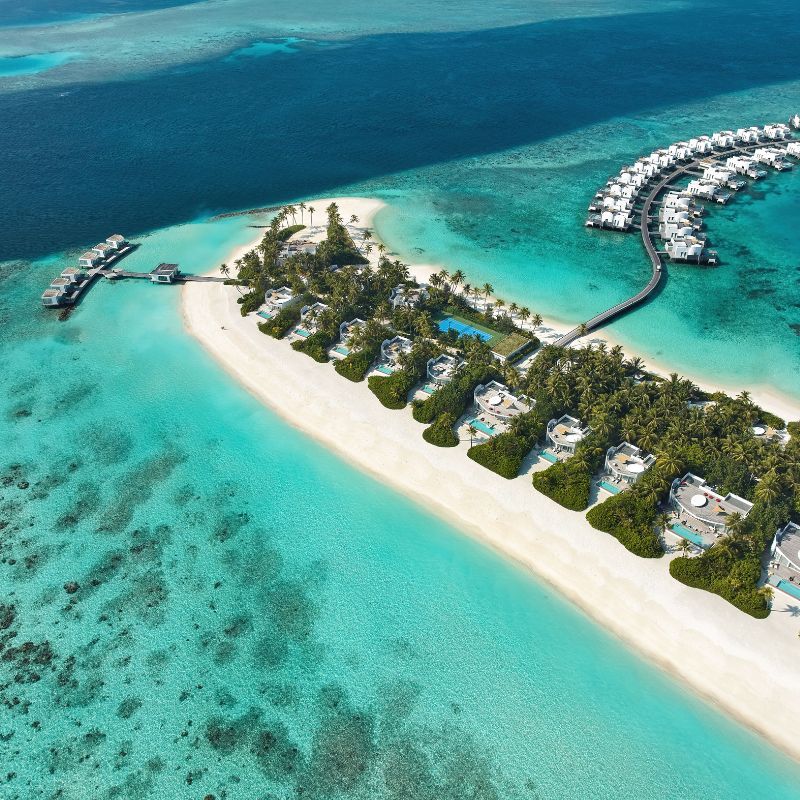
Sylt Island in Germany is home to one of the most advanced wellness resorts in the world. Travel + Leisure India & South Asia’s contributor checks in to discover its surprisingly simple secrets.
It was early morning on a crystal-clear autumn day on the tiny German island of Sylt, and I was chewing toast. And chewing, and chewing. When I finally reached a count of 40, I swallowed. Outside the floor-to-ceiling window of the dining room, long strands of dune grass rippled in a brisk offshore breeze. I took another small bite, sipped some almond milk from a white porcelain cup, and began the count again.
The Lanserhof Cure
This repetitive process is part of what’s known as the Lanserhof Cure. It’s based on the theories of the turn-of-the-last-century Austrian holistic physician Franz Xaver Mayr, who specialised in gastrointestinal health, and who started clinics throughout Austria that are still in operation today. Mayr’s methods are the bedrock of Lanserhof Resorts, a group of state-of-the-art medical wellness retreats with locations in Lans, Austria; Tegernsee, Germany (about 45 minutes south of Munich in the Bavarian Alps), and now Sylt, which can be accessed by ferry, plane, or train.

Each of the Lanserhof properties offers guidance and implementation in topics like orthomolecular medicine (i.e., nutritional supplementation), advanced hormonal diagnostics, light therapies, and intravenous infusions. But in the Lanserhof universe, health and longevity begin and end with—or rather, in—the gut.
My gut and I arrived at Sylt after years of hearing acquaintances rhapsodise about the clinics in Lans and Tegernsee, and the salutary effects of all that Alpine air and scenery. But this island retreat was different: there were wide North Sea vistas, sandy beaches backed by low dunes, and the occasional marshland dotted with fluffy sheep. During my stay, I learned about the negatively charged ions that radiate off this spit of land (which is less than half the size of Nantucket) as well as anti-inflammatory ‘aerosols,’ the micro-drops of seawater inhaled on bike rides and beach walks.
Island Sylt, Germany

The architectural vernacular on Sylt is Frisian— Friesland being a cultural region encompassing parts of the coastal Netherlands and northern Germany—with houses that have steeply pitched thatched roofs and rosy brick façades. Lanserhof, which sits at the edge of a village called List, hews to this local style: the 55 guest suites occupy a thatch-topped structure shaped like a W with glass walls that overlook the sea. While the design is spare, the atmosphere is inviting: sofas and deep, cosy chairs in the lounges are contemporary but comfortable. Beautiful handmade chessboards grace tables, and the impressive library stocks titles by Colson Whitehead and Emily St. John Mandel. I spent a lot of time in the slick sauna and steam rooms, and there’s also a large indoor-outdoor saltwater pool. My room—a bi-level loft—was swathed in calming shades of slate, with a birch-clad ceiling.

I got to know that space well over the first two days of my programme, an eight-day regimen called the Cure Classic Plus. I arrived exhausted after a hectic few weeks during which I had overindulged in prodigious amounts of carbs and sugar. The abrupt switch to 500 calories a day and no caffeine initially left me feeling lethargic and headachey, so I didn’t leave my room much in the first 48 hours.

Nutrition plans at Lanserhof range from Zero (less than 100 calories a day; broth and tea only) to Three, which allows for some fruit and entrées like spelt and zucchini pasta with tofu ‘bolognese’. Together with Thomas Hübner, one of the clinic’s consulting physicians, I’d elected to start at One: toast and almond milk at breakfast, toast and full-fat yogurt for lunch, and a vegan broth for dinner. A shot of bitter herbs (a digestive aid) was proffered before each meal, and a wheatgrass-cucumber juice with vegan omega-3 oil was served alongside it. On waking up each morning, I drank a glass of Epsom salts dissolved in water—a natural, and very potent, purgative.

And then there was the chewing. Much is made at Lanserhof of the importance of proper chewing for healthy digestion, which made the dining room a noticeably quiet place as everyone focused on mindful mastication. As mundane as the food might sound, executive chef Dietmar Priewe worked magic within the parameters, and even after I switched to diet plan Three—which introduced broccoli, potatoes, and blueberries—five days after I arrived, his vegetable broth was the thing I most looked forward to every day. (Juniper berries are his secret ingredient, apparently.)
Plunge into Wellness
My consultations with the extremely amiable Hübner took place in a suite of treatment and examination rooms, where he checked my heart rate and pulse, did a bio-impedance analysis (which included body mass, water weight, and metabolic measurements), listened to my lungs, and examined my tongue and joints—all while firing a barrage of questions about my health and habits. Also available are sonography, 3-D dermal scanning, stress-hormone testing, micronutrient analysis, a post-COVID rehabilitation program, and a host of other body, mind, and aesthetic treatments.

Alongside detox and abdominal stimulation massages, Hübner prescribed a course of simulated altitude therapy called CellGym. This consisted of 45 minutes spent in a reclining chair wearing a mask through which alternating hypoxic (oxygen-poor) and hyperoxic (oxygen-rich) air flows. The practice, Hübner explained, was meant to benefit cellular health at a mitochondrial level. I did four sessions, accompanied by a multivitamin infusion; on my last day, the nurse praised my steady pulse under the strain of oxygen depletion.

Fitness and nutrition lectures and cooking demonstrations were scheduled throughout the week, as were aqua-fitness classes and yoga. But Sylt itself was one of Lanserhof’s selling points, and some of my favourite mornings were spent exploring the surroundings on one of the property’s e-bikes.

One day I cycled a few miles to the Westrand, a wild, windswept beach where I sifted through drifts of seashells, waded into the North Sea, and inhaled those salt-tinged aerosols I had been told about. Another day, I visited the village of Keitum, where 250-year-old sea captains’ houses sit alongside elegant boutiques selling Loro Piana scarves and Ralph Lauren sweaters. (For years, the island has been home to some of the most expensive real estate in the country, earning it the nickname ‘the Hamptons of Germany’.)

Back at the resort, I sampled an offering from the clinic’s aesthetics menu: the 90-minute JetPeel facial, during which various brightening, firming, and replenishing serums were blasted into my skin via a handheld wand. At just over INR 49,171, it wasn’t cheap (cosmetic treatments are not included in Lanserhof programmes), but the results were superb. For three days afterward, my jawline looked as if it had been surgically contoured, and a week later I still had remarkably even skin tone.
On checkout day, I learned that I had lost a little more than five pounds and an inch off my waist. More importantly, I had shed the fuzzy, cotton-stuffed brain fog I’d arrived with. But best of all, the Lanserhof Cure was like a cheat sheet I could take home with me, one that I continue to use all these months later. Who knew that feeling like a new person involved elements as simple as bread, broth, time in nature—and perfecting the art of chewing?
Frequently Asked Questions (FAQs)
Answer: Lufthansa operates various connecting flights from New Delhi and Mumbai to Sylt.
Answer: Lanserhof Sylt has 55 guest rooms and suites and offers panoramic views of Lister Harbour as well as the adjacent protected landscape. The Cure Classic Plus programme begins from INR 6,59,364.









